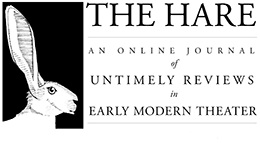Submitted by Hare Editor on
This new issue of The Hare represents both a first and a last. It’s the first issue in quite some time and the last under its founding editors. Jeremy Lopez is assuming the editorship of Shakespeare Quarterly – a lateral move from The Hare – and the event seemed a good moment to transfer the editorship to two early career scholars who will bring to it both the energy and urgency it needs to reflect emerging issues in the literature of the English Renaissance. Those two editors are Casey Caldwell (PhD candidate in the Department of English at Northwestern University) and Amy Kenny (Visiting Assistant Professor at UC Riverside). At the end of this note appears their reimagined vision for The Hare, an inspired evolution of the founders’ initial conception for the journal. Their first jointly-edited issue will appear in fall 2018, and already promises as stellar line up of essays.
The current issue (3.1) offers another first, the first essay in The Hare to reveal an archival discovery, a long-misread signature of Edmund Tylney on the 1590s manuscript of the Book of Sir Thomas More. Jonathan Walker has determined that Tylney’s signature, always transcribed as “E Tylney,” in fact reads “Ed Tylney,” making the early modern master of revels sound something like a Baltimore cop. Obscured in the initial “E” is a faint “d,” and Walker deftly analyzes the trace of this signature through the prism of Derrida’s “Signature Event Context,” noting that “the signature falls short of its author’s intention” while it “graphically exceeds its audience’s apprehension.” Observing the manuscript’s history of (mis)apprehension, Walker concludes that the “text constantly, and even now, surpasses our abilities to account for it.”
This ed. note similarly signals an attempt to exceed – or extend – the editors’ intentions for The Hare, with every expectation that it will fall short. The handoff from one editorial team to another represents a signature event, where the collaborative work of many hands produces, we hope, a singular product. We thank you for following The Hare, and request you continue to do so. It’s in good hands.
Paul Menzer
Jeremy Lopez
Editorial Statement: Casey Caldwell and Amy Kenny
The Hare is an online, peer-reviewed journal, publishing untimely reviews of books, articles, and performances in early modern theater. This journal provides a venue for the contention and revaluation of old scholarly work in contemporary scholarly debate. We invite you to interpret “old” creatively, though traditional reviews of recent publications will not be considered. We welcome untimely reviews of books and articles that our field has overlooked or overemphasized to its detriment. We also welcome untimely performance reviews in early modern theater, emphasizing fascinating, bizarre, passed-over performances that have been excluded from traditional performance history. The Hare will be the home for brief, provocative pieces on these lost, invisible productions. Finally, we also solicit future-looking pieces, from theater artists and scholars for productions they would like to see produced--arguing for what they see as the Cymbeline that Philadelphia most needs today, or The Shoemaker's Holiday in Beijing, for example.
We invite contributions focusing on a wide range of early modern theater, including but not limited to Shakespeare’s plays. We are excited to publish untimely reviews by theater artists with a vision for the future of early modern drama, alongside scholars inspired to reassess the past in order open up new possibilities for the next generation of scholarship. Challenging the history of our field--by bringing inspiring work out of the dark for the first time or by contesting the place of long-visible texts--foments the potential for dramatically new ideas, imaginaries, and methodologies within the study of early modern theater.
